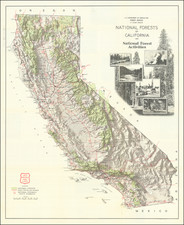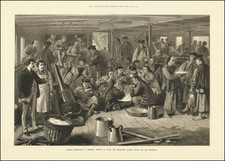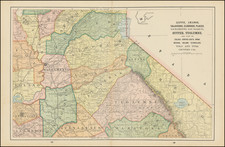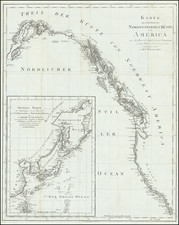A Pair of Stunning Full Plate 19th-Century Tintypes of an African American Man and Woman
Servants of Noted Texas Ranger John Coffee Hays, Likely Brought to California as Enslaved People
Two rare original tintype or ferrotype portraits believed to depict Eliza Calvert Hays and Henry Lucius Brown, two African American people living in the Bay Area of California. Eliza was brought to California as a "servant" of John Coffee Hays and Susan Calvert Hays. Col. Hayes, a renowned Tennessee-born Texas Ranger and Mexican War veteran, came to California during the Gold Rush. Hays was elected sheriff of San Francisco County in 1850, was appointed United States Surveyor General for California in 1853, and is also remembered as a founder of Oakland, California. Despite his southern roots Hays attempted to remain neutral during the Civil War. His Oakland estate, a showplace called “Fernwood," was described as “one of the most beautiful of the State....located at the base of verdure-clad hills of the Coast Range, in a quiet nook....lordly oaks....a handsome building and exquisite area. Indescribable views in every direction.”
The present pair of tintypes may shed light on the complex and often concealed history of African Americans in the West, particularly the lives of enslaved African Americans who were brought to California, a free state, by their enslavers.
The woman depicted in one of the present tintypes, possibly named Eliza Calvert Hays, may have accompanied Col. Hays's wife, Susan Calvert Hays, when she traveled from San Antonio to join her husband in California in September 1850. The accompanying portrait is believed to be Henry Lucius Brown, who may have also worked for the Hays family. According to James Kimmins Greer, in his book, Colonel Jack Hays: Texas Frontier Leader and California Builder:
...on September 29 [1850] [Mrs. Hays] bade good-by to Mrs. Samuel Maverick and numerous other San Antonio friends. Accompanied by Bob Hays and a faithful servant, she was soon on the Gulf of Mexico bound for California by way of Panama... Their ship arrived at Charges late one evening...the party... rode mules the remainder of the way across the isthmus... On December 7 Hays went down to the wharf on "steamer day." He met a newspaper reporter, who had rowed out to the ship and copied the purser's roster, and was now hurrying up the wharf before the Columbus moved to her moorings. On the list of arrivals was "Mrs. Hays and serv't ... B. Hays."
The tintypes are dignified portraits of well-dressed, middle-aged African Americans, posed in front of a standard backdrop of a painted glade. Both portraits were made in the same photographer's studio, with the identical painted backdrop characteristic of tintype photographers of the 1870s and 1880s. Some straw or artificial grass is splayed over a bit of ornate metal fencing, completing the studio scene. Untypically, the present tintypes are of the large full-plate size, which results in a more dignified portrait capable of displaying better detail than the usual small sixth plate format commonly made by itinerant or amateur photographers of the time.
Historical Context of Enslaved People in "Free" California
In the 1850s, California was officially a "free state," meaning slavery was legally prohibited. However, the state tacitly allowed enslaved people to reside within its borders. In 1852, California enacted legislation setting forth that any enslaved person who had entered the region prior to it becoming a state was entitled to freedom. This legislation suggests a paradox since the state constitution had already explicitly prohibited slavery. This contradictory legal situation begs questions regarding the status of erstwhile enslaved people in California, including Eliza and Henry, who were likely brought to California by their enslavers. The evidence suggests that Eliza was not just a "servant," as was euphemistically indicated in the abovementioned ship passenger roster, but was, in fact, brought to California as an enslaved person by the famous Texas Ranger, John Coffee Hays, or his wife.
The Hidden Histories of Enslavement: "...evident only in traces"
A recent book by Rachel Stephens, Hidden in Plain Sight: Concealing Enslavement in American Visual Culture (2023), suggests the potential of photographic evidence to examine the intentional concealment of the history of slavery within a broader visual culture of 19th-century America:
The purposeful concealment of the history of slavery and apathy toward African American heritage extended from individual families to cultural institutions that discarded or dismissed significant objects.... the private archival record... is surprisingly quiet concerning slavery. Some families spoke openly about it, but generally references to the institution are dotted erratically across the historical record, evident only in traces. Enslavers had long been suspicious of speaking too openly about their practices.
While Stephens' book focuses on southern pro-slavery antebellum visual culture, the present tintypes of African American people in the West would seem to suggest possibilities in extending such efforts to encompass traces of enslavement in the post-Civil War period.
Indeed, Stephens examines an 1878 photograph of Alexander H. Stephens, erstwhile Vice President of the Confederacy, posing in a wheelchair while an African American man attends to him. The story of the African American servant, likely Quin Stephens - the son of an enslaved couple who continued to work at Stephens' Liberty Hall in Crawford, Georgia after the Civil War - is an example of a history "hidden in plain sight" within a photographic object.
Summary
The identification of the present tintypes as depicting servants of John Coffee Hays, may help elucidate the hidden histories of African Americans in the West. These tintypes provide a tangible connection to the lives of the people depicted, while at the same time reminding us of the complex dynamics of enslavement and freedom in a state that officially prohibited slavery but did not fully eradicate it. They stand as evidence of the struggles of African Americans in a region where the lines between freedom and slavery were blurred. The tintypes help us bear witness to untold stories of African Americans who played a vital role in shaping the West, even in the face of the injustices of slavery. By recognizing the significance of the lives of the individuals depicted in these tintypes, we can honor and amplify the voices of those who have often been marginalized in U.S. history.
Rarity
Full plate 19th-century western tintypes are quite scarce, and such fine full-plate tintypes depicting African Americans in the West are especially rare. For example, the two-part sale of the Steve Turner Collection of African Americana, which focused on western photographs and visual material, did not include a single full plate tintype, despite comprising dozens of lots of African American portraits.
Provenance.
From a sale of personal belongings of Col. John Coffee Hays.











![[Governor of Virginia] The Right Honble William Anne, Keppel, Earl of Albermarle, Viscount Bury, Baron of Ashford, Groom of the Stole, Governour & Captn General of Virginia, Colonel of the Coldstream Regiment of Fort, Lt. General of His Majesty's Forces, Ambassador Extraordinary & Plenipotentiary to the Court of France, one of the Privy Council, & Knight of the Most Noble Order of the Garter &c.](https://storage.googleapis.com/raremaps/img/small/60432.jpg)


![[The 5 Californias] Carte de la Californie Suivant 1. La Carte manuscrite de l'Amerique de Mathieu Neron Pecci olen dressee a Florence en 1604, 2. Sanson 1656 . . .](https://storage.googleapis.com/raremaps/img/small/97983.jpg)

